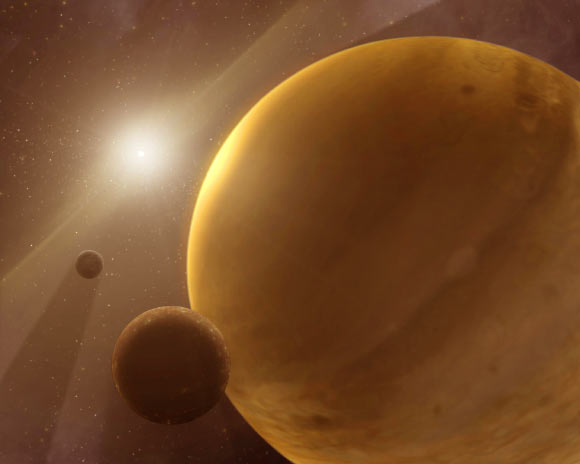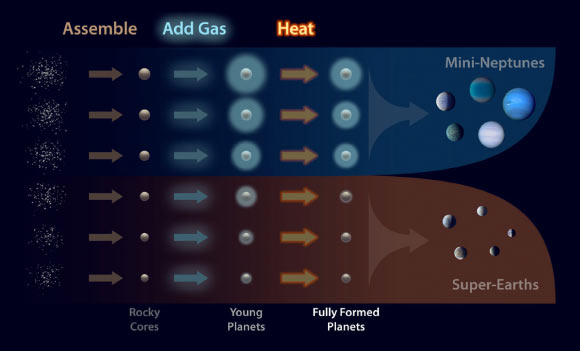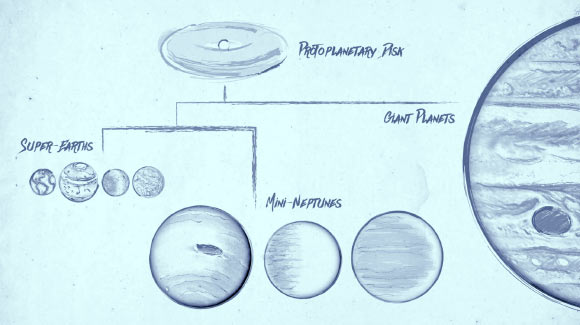Astronomers have classified extrasolar planets in the same way that biologists identify new species and have learned that the majority of planets found to date fall into two distinct size classes: rocky, Earth-size planets and gaseous planets smaller than Neptune.

The Milky Way Galaxy has a strong preference for two types of planets: rocky planets up to 1.75 times the size of Earth, and gas-enshrouded mini-Neptunes, which are from 2 to 3.5 times the size of Earth. Our Galaxy rarely makes planets with sizes in between these two groups. Image credit: NASA / JPL-Caltech.
“We like to think of this study as classifying planets in the same way that biologists identify new species of animals,” said Benjamin J. Fulton, of Caltech and the University of Hawaii.
“Finding two distinct groups of exoplanets is like discovering mammals and lizards make up distinct branches of a family tree.”
Since NASA’s Kepler space telescope launched in 2009, it has identified and confirmed more than 2,300 exoplanets.
Kepler specializes in finding planets close to their stars, so the majority of these planets orbit more closely than Mercury.
Most of these close-in planets were found to be roughly between the size of Earth and Neptune, which is about 4 times the size of Earth.
But, until now, the planets were found to have a variety of sizes spanning this range and were not known to fall into two size groups.
“In the Solar System, there are no planets with sizes between Earth and Neptune,” said Dr. Erik Petigura, a Hubble postdoctoral fellow at Caltech.
“One of the great surprises from Kepler is that nearly every star has at least one planet larger than Earth but smaller than Neptune.”
“We’d really like to know what these mysterious planets are like and why we don’t have them in our own Solar System.”

This diagram illustrates how planets are assembled and sorted into two distinct size classes. First, the rocky cores of planets are formed from smaller pieces. Then, the gravity of the planets attracts hydrogen and helium gas. Finally, the planets are ‘baked’ by the starlight and lose some gas. At a certain mass threshold, planets retain the gas and become gaseous mini-Neptunes; below this threshold, the planets lose all their gas, becoming rocky super-Earths. Image credit: NASA / Ames Research Center / JPL-Caltech / R. Hurt.
Using the W. M. Keck Observatory in Hawaii, the astronomers measured the sizes of 1,305 stars in Kepler’s field of view to determine the radii of 2,025 planets with exquisite precision.
“Before, sorting the planets by size was like trying to sort grains of sand with your naked eye,” Fulton said.
“Getting spectral data from Keck is like going out and grabbing a magnifying glass. We could see details that we couldn’t before.”
With Keck’s new data, the authors were able to measure the sizes of the Kepler planets with 4 times more precision than what had been achieved previously.
When they examined the distribution of planet sizes, they found a surprise: a striking gap between the groups of rocky Earths and mini-Neptunes.

This sketch illustrates a family tree of exoplanets. Planets are born out of swirling disks of gas and dust called protoplanetary disks. The disks give rise to giant planets like Jupiter as well as smaller planets mostly between the size of Earth and Neptune. Image credit: NASA / Ames Research Center / JPL-Caltech / Tim Pyle.
The cause of the gap is not clear, but the team has come up with two possible explanations.
The first is based on the idea that nature likes to make a lot of planets roughly the size of Earth. Some of those planets, for reasons that are not fully understood, end up acquiring enough gas to ‘jump the gap’ and become gaseous mini-Neptunes.
“A little bit of hydrogen and helium gas goes a very long way. So, if a planet acquires only 1% of hydrogen and helium in mass, that’s enough to jump the gap,” said Andrew Howard, professor of astronomy at Caltech.
“These planets are like rocks with big balloons of gas around them. The hydrogen and helium that’s in the balloon doesn’t really contribute to the mass of the system as a whole, but it contributes to the volume in a tremendous way, making the planets a lot bigger in size.”
The second possible reason that planets don’t land in the gap has to do with planets losing gas.
If a planet does happen to acquire just a little bit of gas — the right amount to place it in the gap — that gas can be burned off when exposed to radiation from the host star.
“A planet would have to get lucky to land in the gap, and then if it did, it probably wouldn’t stay there,” Prof. Howard said.
“It’s unlikely for a planet to have just the right amount of gas to land in the gap. And those planets that do have enough gas can have their thin atmospheres blown off. Both scenarios likely carve out the gap in planet sizes that we observe.”
The research has been accepted for publication in the Astronomical Journal (arXiv.org preprint).
_____
Benjamin J. Fulton et al. 2017. The California-Kepler Survey. III. A Gap in the Radius Distribution of Small Planets. AJ, in press; arXiv: 1703.10375







